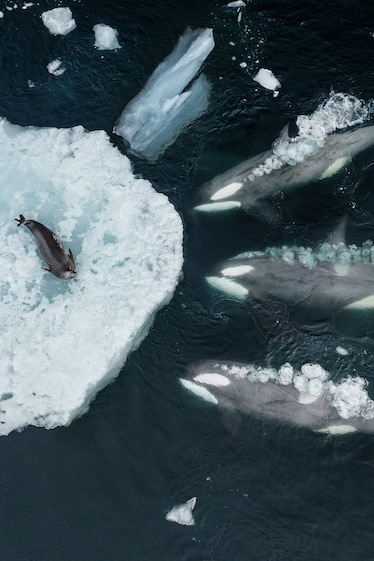The first time the Weddell seal notices the orcas, it’s already surrounded. Until moments before, it had been resting on an ice floe deep in an Antarctic channel. Then three killer whales’ heads appear, bobbing up and down. The orcas are hunting.
On this sheet of sea ice, the nearly thousand-pound seal would be unreachable for most marine predators. But these orcas—a matriarch with her daughter and granddaughter—are three of about a hundred known to have mastered a hunting technique called wave washing. The secret: working together to turn water into a weapon.
The orcas, having identified their target, form a battle line and start charging toward the floe. Just before reaching it, they rotate to their sides in a single, synchronized motion and plunge underwater. The momentum creates a wave so powerful that it floods the ice sheet, cracking the surface and whipping the flailing seal around. Slowly and methodically, they repeat the charge. The ice fractures more. On the third charge, the wave sends the seal flying into the sea. It scrambles to climb onto a piece of ice, then disappears from view, grabbed from below by a killer whale.
“It’s completely sinister to watch,” says wildlife filmmaker Bertie Gregory, who’s spent a decade tracking the orcas, known as B1, a population of pack ice killer whales. The level of intelligence that goes into making each wave “is staggering,” he says. “This isn’t subtle. They are problem solving using very complex teamwork. They’re using water as a tool.” Sometimes it’ll take one wave, about five minutes, before a seal is flung into the sea. Other times a pod can wave wash up to 30 times, about two to three hours, before getting the prey. Scientists rarely see failed hunts. “This behavior is not innate; it’s learned and mastered over decades,” says Gregory. “Every time they make waves, it almost feels like more of a teaching experience than hunting.”
But as Antarctica warms and sea ice vanishes, Weddell seals are increasingly staying on land, out of orcas’ reach. To track how the B1 orcas cope with a warming habitat, scientists have identified all hundred or so individuals. They’ve found B1s are losing about 5 percent of their population every year. Whether this subgroup “will go extinct or just adapt their behavior, we don’t know,” says Gregory. But with fewer opportunities for the orcas to wave wash, “we’re seeing an extinction of a culture.”
This story appears in the November 2023 issue of National Geographic magazine.
